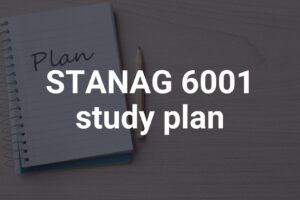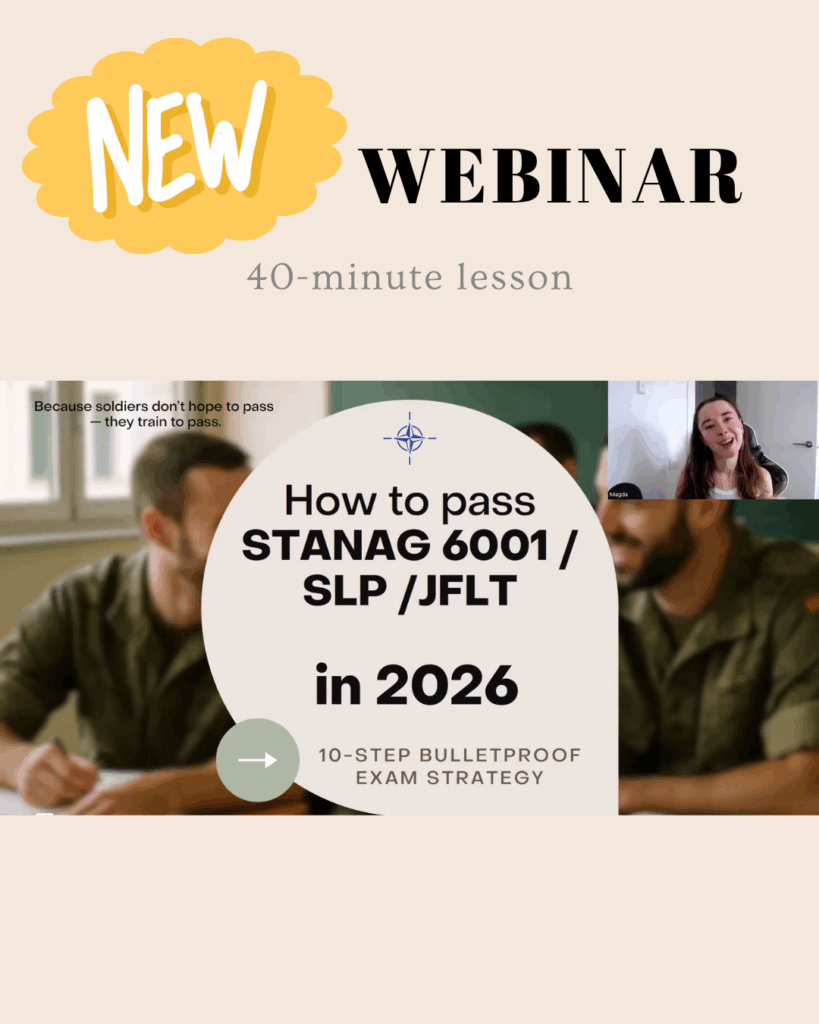
STANAG LEVEL 3 SPEAKING EXAM in Poland (COVID-19 pandemic edition, summer 2021)
DDM = Distance, Disinfection and a Mask
According to the current sanitary regulations, it is mandatory to wear a mask, keep the distance and disinfect hands while in closed spaces, which includes the preparation room as well as the examination room.
Preparation room
The speaking part of STANAG 6001 Level 3 exam is taken in pairs. Candidates are invited to the preparation room and to the examination room at the hours scheduled beforehand. An examinee is not allowed to enter the room until the examiner verifies examinees’ identities by inspecting the ID document (or another approved document).
Having verified the examinees, each person in a pair draws the first part of the exam set – a briefing topic and takes a seat. The desks are disinfected and separated from each other according to the sanitary restrictions established. There is a sheet of paper on each desk to facilitate note-taking, so don’t bother to bring any. What you definitely need to bring is a pen.
After having taken their seats, an examiner explains the examination process. The instructions are given in Polish. The first task includes a briefing, but actually it consists of two parts: A and B, which will be discussed in details below. Each candidate has approx. 15 minutes for preparing a briefing.
The next exam pair enters the room while the one being examined has been tested for roughly 10 minutes.
Bear in mind that there is no extra time for preparing the second part of Task 1, namely questions related to a briefing, neither before the Task 2, which is a discussion (nor the examiner’s questions in that part).
The exam takes approximately 25 minutes per pair.
There can be simultaneously a few pairs in the preparation room, all of them preparing to take the exam in front of different examination boards, which are drafted randomly.
When the preparation time is up, an examiner takes a pair of candidates to the examination room or explains to them where to go.
What one can bring from the preparation room to the examination room is the sheet of paper with their notes and the briefing topic drafted.
There will be at least two examiners in the examination room. In case there is an odd number of examinees, one of the examiner will take the role of the speaking partner during the discussion and the briefing.
TASK 1 – BRIEFING (monologue)
The exam starts with the examinee saying the number of the briefing set, which is set down by the examination board in the evaluation record.
Task 1 is divided into two parts. In part one (A) an examinee is asked to deliver a briefing, a 3- or 4-minute monologue. When one of the examinees has finished, the other one is asked to comment on the briefing delivered for 1-2 minutes and ask questions.
IMPORTANT: While delivering a briefing, an examinee CANNOT read a briefing script. Conversely, they are encouraged to glance down at their notes.
It is recommended to write bullet points (preferably in a table format – a tip for visual learners) and group the pros and cons accordingly. It might come in handy to write down some specific words that an examinee wishes to use, as reading aloud long pieces is not allowed.
Then it’s the other examinee’s turn and the roles are switched. This time the examinee focuses on listening to a briefing and coming up with relevant questions. The questions need to be prepared while the other person is speaking, there is no extra time for it! A recommended number of question is up to 3 or 4. They can be written down and read directly from the notes. It is advisable to use indirect questions, which are more formal that direct questions. The maximum number of points that an examinee can receive for this part of the exam is 10.
TASK 2 – DISCUSSION
Task Two is divided into two parts.
After having finished Task 1, one of the candidates draws a set of two identical sheets with the discussion topic, which candidates need to discuss together and take a (preferably) common stance on an issue. There are also 3 extra bullet points that the examinees should discuss during this part of the exam.
This part of the exam starts when one of the examinees shares the topic with the examination board.
Just a friendly reminder – there is no prep time!
Part A: Discussion over given topic
In Part A both candidates discuss a topic given. The discussion should take around 5-6 minutes. It is of a paramount importance not only to express one’s views, but also to be involved in a conversation by asking questions, supporting one’s ideas with logical arguments, and coming up with a conclusion. One of the assessment criteria is the ability to actively participate in a discussion both by initiating and maintaining a conversation.
Another assessment criterion is accuracy and the language used.
Instead of using simple expressions such as:
“I think that living in the city has more advantages than living in the country.”
Which are actually correct, but won’t impress the examiners when it comes to a wide range of vocabulary. Try using more sophisticated expressions:
“To tell the truth, to ensure the safety of civilian people during military conflicts the best course of action would be to build special buffer zones.”
Part B: Follow-up questions
In Part B, each candidate has to answer examinee’s follow-up questions. If the discussion touched upon the topic of traveling, questions around the topic may be expected – travel safety or means of transport, to name a few. The conversation lasts 5-6 minutes and again, there is no time to prepare for this part of the exam. Candidate’s fluency will be taken into consideration and assessed. Here is a tip – use the Buying Time strategy, in case you need a few extra seconds to wrap your head around the topic.
There are maximum 10 points that can be scored for this part of the exam.
Assessment
Candidate’s speaking skills are assessed by two examiners. The maximum number of points that can be scored in the Speaking exam is 20, whereas 14 points in total (for both tasks) are necessary in order to pass the exam.
After having finished the exam, the examination board takes away both candidate’s notes and exam sets for both parts of the exam.
The exam tasks at the level 3 are written in English.
This article was created in collaboration with Marta Buniak. The link to the original article in Polish. (Translated by Military English Teacher)




